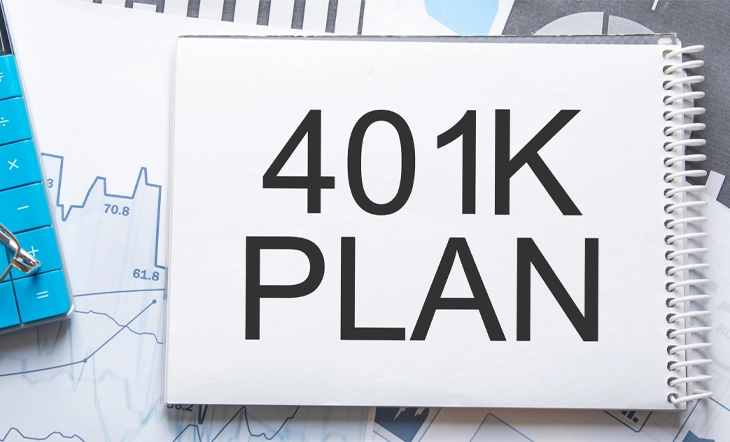Impact of New Tariffs on Your 401(k) by Age

A number of changes have been proposed and implemented since President Donald Trump returned to office. One of the most significant ones has been the April 2025 tariff announcement. This policy introduced a 10% baseline tariff on all imports. Tariffs are a type of tax imposed on imported goods and services by the government. They can have a direct impact on the stock market, and by extension, on your retirement investments, including your 401(k). The announcement has already changed global trade dynamics. It can further result in increased market volatility, inflation, and sector-specific disruptions.
This article will break down how these new tariffs might affect 401(k) investors across different age groups. If you are unsure how this impacts your personal retirement strategy, you can also consult a financial advisor to understand the impact of tariffs on the stock market and how you can protect yourself.
Table of Contents
How do tariffs affect retirement savings and 401(k), and what can you do about it
1. Age: 20 to 30
If you are in your 20s, a stock market slump caused by new tariffs may feel scary, but you have one decisive advantage, which is time. Since you are decades away from retirement, short-term market volatility due to new tariffs should not affect your long-term 401(k) strategy. In fact, these downturns can present opportunities to buy into the market at lower prices. Still, while your 401(k) may benefit from long-term investing, your monthly budget could feel the impact of tariffs right now. This, in turn, can impact your ability to contribute to your 401(k) and other retirement savings.
According to research from the Yale University Budget Lab, the average U.S. household could lose roughly $3,800 per year in purchasing power due to the new tariffs implemented under President Donald Trump’s trade policies. These costs can show up in your day-to-day purchases. For instance, items like clothing, footwear, gloves, handbags, and wool or silk products will see price hikes between 10% and 20%. Since these products are common among younger people, spending on such items can influence the budgets of younger earners and come in the way of their ability to invest in their 401(k)s.
You might be tempted to scale back your retirement contributions to handle these rising costs. However, you must not aim to do so. Consider contributing a steady percentage of your salary to your 401(k) at the beginning of your career to ensure you get a good start in life with respect to savings. You can maintain an investment of 5% to 10% of your salary and increase it over time. This can help you build savings and also give you a good employer match. Make sure to budget more carefully. Review your spending habits and find areas to cut, at least for the time being. For example, you may consider shopping for secondhand products or switching to homegrown brands, so you can save more now and keep your 401(k) contributions on track. It is important to watch your credit card use, too. Avoid borrowing to maintain a lifestyle that you cannot afford. Instead, prioritize building healthy savings habits and keep at least three to six months of expenses in a liquid savings account for emergencies.
The correlation between tariffs and your 401(k) is considerably low in your 20s. While tariffs may restrict your budget and cause stock market apprehensions, you still have a lot of time on your hands. So, even if your 401(k) balance seems to be dropping right now, focus on contributing consistently to build your future retirement savings.
2. Age: 30 to 40
Even in your 30s, you have a lot of time left to retire, so you do not have to be so worried. However, it is important to note that this decade is a powerful time for growing your 401(k) savings. You are likely earning more than you did in your 20s, which means you can afford to increase your contributions and take advantage of higher employer matches. Still, it is important to be mindful of external pressures on your budget. According to the Yale Budget Lab, tariffs on imports like automobiles, car parts, etc., are raising prices. The cost of motor vehicles and car parts could increase by over 8%. These items typically enter your life more frequently in your 30s as you start a family or move to the suburbs. While you may be earning more, your expenses are also likely to grow in your 30s. If you are buying a home or having children, higher prices due to tariffs can burden your monthly cash flow. So, before making large purchases like a car, compare costs, consider pre-owned options, and delay any non-urgent upgrades.
Your 401(k)-investment strategy should also reflect your time horizon. In your early to mid-30s, your 401(k) portfolio can lean heavily toward equities. Stocks offer long-term growth, and at this stage, you have enough time to recover from temporary losses due to market downturns. Even though markets might struggle in response to trade wars and tariff-related news, you can stay invested through these cycles. However, as you approach your late 30s, say 38 or 39, you may consider thinking about portfolio diversification. You can slowly add more fixed-income instruments to balance the risk from your equity holdings. This can help reduce volatility. Also, make sure you are maintaining a healthy emergency fund, ideally covering three to six months of expenses. This will ensure that you do not need to touch your 401(k) in case of a job loss or an unexpected expense inflated by tariff-driven price hikes.
3. Age: 40 to 50
This decade is critical. While there is still time to build your nest egg, there isn’t enough to fully recover from significant financial setbacks. That is why understanding the impact of tariffs on the stock market becomes more important than ever. Tariffs imposed on foreign goods are expected to raise the overall U.S. inflation rate. A lot of economists caution that these policies can increase the cost of consumer goods and services and reduce your purchasing power. More importantly, tariffs may also influence stock market performance, especially if they result in retaliatory tariffs from other nations. This can affect equities across sectors and even global markets, making it essential to re-evaluate your 401(k) exposure to international funds and vulnerable domestic sectors.
You must consider rebalancing your 401(k) once or twice a year during this phase. Keeping a mix of growth and income-generating investments can be suitable. At this stage, it becomes essential for you to consider working with a financial advisor, too. An advisor can help you adjust your asset allocation within your 401(k). A personalized retirement plan can help account for inflation, market volatility, and your shorter time horizon.
On the other side, inflation is another important consideration in your 40s. While some major expenses in your 40s and 50s, like your mortgage, property taxes, and insurance premiums, are tied to domestic conditions and may not be directly impacted by tariffs, others could rise significantly. Imported goods, such as smartphones, laptops, electronics, household appliances, imported or partially imported cars, and even clothing, and certain fruits and vegetables, may become noticeably more expensive. If you have children in school or college, you may also have to account for tariff-related price hikes in consumer goods and tech essentials. You must make room in your budget for these rising costs to keep your retirement planning on track.
4. Age: 50 to 60
If you are in your 50s, you may likely have only a decade or so left before you begin withdrawing from your 401(k). The tariffs’ effect on the stock market can have a significant impact on your financial security. If trade tensions escalate, certain sectors, like manufacturing, automotive, and technology, may experience downturns. This could lead to lower returns for investors who are heavily exposed to equities through their 401(k), especially in these sectors. Unlike in your 30s or 40s, you now have less time to recover from major losses. In addition to equity market risks, tariffs contribute to rising prices. Inflation can reduce the purchasing power of your retirement savings. What is more concerning is that inflation also affects bond yields. If interest rates remain low while inflation increases, the real returns on your fixed-income investments could drop. This creates a double-edged sword. While stocks may be volatile, bonds may not offer much protection. This is an ideal time to consult with a financial advisor to develop a comprehensive financial strategy. Your plan should go beyond your 401(k) and take into account all aspects of your financial life, including your Social Security timing, pensions, healthcare costs, tax strategies, and estate planning.
Consider diversifying your portfolio to include inflation-protected securities like Treasury Inflation-Protected Securities (TIPS). These can offer some cushion against rising prices while preserving capital. It is also a good time to reduce exposure to high-volatility sectors and shift towards more stable sectors. Some sectors, such as utilities and consumer goods, may be more stable during times of high inflation rates or trade-related market disruptions.
Another vital step is reassessing your asset allocation. In your 50s, you must make a gradual shift away from aggressive stock-heavy portfolios toward a balanced mix of equities and debt. The exact ratio will depend on your personal risk tolerance and retirement timeline, but a more conservative stance may help protect your savings from the impact of tariffs on the stock market. You must also be mindful of any large expenses, such as home renovations that a lot of people undertake during the years before they retire.
5. Age: 60 and beyond
If you are 60 or older, you may already be retired or are planning to retire very soon. At this stage, preserving the funds within your 401(k) and ensuring a reliable income stream is essential. With market volatility induced by tariffs, your focus should shift from growing your portfolio to sustaining it through retirement.
If your retirement assets are still significantly invested in equities, and the market declines due to trade tensions or retaliatory tariffs, the value of your portfolio could drop. This is particularly concerning if you are making systematic withdrawals from these accounts, as pulling money out during a downturn can lock in losses. This is also known as sequence-of-returns risk. To mitigate this, retirees should consider reducing the withdrawal rate temporarily or drawing from other income sources until the market stabilizes again. Ideally, by this point in life, your portfolio should already be more conservative with a larger allocation to fixed income and cash-equivalent assets.
It is also helpful to examine your entire retirement income picture, not just your 401(k). Sources like Social Security benefits, pensions, and annuity payouts tend to be less affected by tariffs or stock market swings. You may be in a better position if a significant portion of your income comes from these protected sources. In that case, you can consider temporarily lowering your 401(k) withdrawals and allowing your account time for market recovery.
However, inflation will still be a key concern in these years. As tariffs increase the cost of imported goods, you may find that your everyday expenses rise. Over time, this inflation can erode your purchasing power. Items most susceptible to tariff-related price increases include imported electronics, appliances, clothing, and vehicles, as well as some types of produce and coffee. You must also understand how healthcare can be impacted by this, as it is going to account for a large chunk of your spending during this phase. Even though most medical services are delivered domestically and will not be directly impacted, prescription drug costs could rise, since many drugs or their ingredients are sourced from abroad. So, you must be prepared for changes in your out-of-pocket expenses, even if your Medicare premiums remain stable in the short term.
Domestic manufacturers may raise their prices in response to reduced competition from imports. As a result, even goods made in the U.S. may become more expensive. Hence, you must consider budgeting more conservatively and prioritizing your needs over wants. Ensure your emergency fund is intact and consider using short-term bond ladders or Treasury Inflation-Protected Securities (TIPS) to hedge against inflation.
A country may impose tariffs for several reasons. However, it is primarily to make imported goods more expensive and to encourage consumers to buy domestically produced items. This helps protect local businesses and can boost homegrown companies. As trade wars increase, you may consider allocating more of your portfolio to U.S.-based companies. Having said that, it is important to recognize that market volatility following the introduction of tariffs may be temporary. The economy takes time to adjust. So, you must stay calm and give your 401(k) and other retirement investments time to recover. No matter your age, you must consider cutting unnecessary expenses, maintaining a healthy emergency fund, or even taking on part-time work to manage inflation right now. You must also understand that your 401(k) may react differently to market swings depending on how close you are to retirement, which is why it is essential to work with a financial advisor for personalized guidance.
A team of dedicated writers, editors and finance specialists sharing their insights, expertise and industry knowledge to help individuals live their best financial life and reach their personal financial goals. We believe that there is no place for fear in anyone's financial future and that each individual should have easy access to credible financial advice.
Related Article
9 min read
03 Oct 2025
6 Strategies to Protect Ultra-High-Net-Worth Family Wealth
Generally, you are considered high-net-worth if you have more than $1 million in highly liquid assets, such as cash, stocks, and other investments that can be converted into cash relatively easily. The exact number can vary depending on the bank or financial institution, but $1 million is the usual benchmark. Banks and wealth management firms […]
9 min read
15 Sep 2025
Portfolio Managers vs. Investment Advisors: How Do the Two Differ?
When it comes to building and handling a portfolio, it often feels like a two-person job. After all, your portfolio is more than just numbers. It is, in fact, the door to your future. It carries the potential to fund your dreams, protect you in times of uncertainty, and give you the freedom to reach […]
10 min read
18 Jun 2025
5 Best Long-Term Investment Strategies for 2025
“Good things come to those who wait.” Haven’t you heard that time and again? There is a reason some sayings stand the test of time and are used across the globe. Because they hold real value. In the world of investing, this could not be truer. Long-term investing is where you put your money to […]
10 min read
17 Jun 2025
Key Trends and Concerns for Investors in 2025
This is an interesting time for the world. New advancements, disruptions, and innovations are all around. Whether it is finance, technology, healthcare, entertainment, or even food, fresh trends are emerging across the board. As an investor, you can’t afford to ignore what is happening in the world around you. The shifts you are seeing today […]
More From Author
14 min read
23 Jan 2024
How to Determine If Your Financial Advisor Is Doing a Good Job Each Year
The decision to hire a financial advisor is a prudent move. Seeking professional advice can provide valuable insights and a roadmap to achieve your financial goals with strategic planning. But the world of financial advice is crowded. While some advisors bring qualifications, expertise, and a commitment to your financial well-being, others may fall short of […]
4 min read
30 Oct 2023
How to prepare for a meeting with your Financial Advisor
What do you do before you visit a doctor? Understand your condition, prepare for all the questions that the doctor would ask, ensure all your test reports and medical history documents are in order and so on. Preparation is a must even before you visit a financial advisor. Table of Contents7 Things to do to […]
3 min read
26 Jul 2019
Best Retirement Calculators to plan Retirement
It is said that a goal without a plan is just a wish. This holds true even for retirement planning. You dream of a peaceful retired life. To achieve that you must plan for your golden years well in time. Various retirement tools make your task easier. For example, a retirement calculator helps you calculate […]
4 min read
23 Mar 2020
How to get rid of Money Anxiety?
Is money anxiety even a thing? Yes, it is! Money anxiety is something we all have dealt with or are likely to deal with at some point in our life. Sometimes, you may not even know that you are money anxious unless you take note of it. But the good part here is that money […]

Find & Compare Top Financial
Advisors in your area
Get Started
Popular Posts
Categories
- Business Finance (2)
- Education Planning (31)
- Estate Planning (31)
- Financial Advisor (1)
- Financial Advisor Guide (55)
- Financial Planning (138)
- Investment Management (99)
- Personal Finance (15)
- Portfolio Management (1)
- Retirement (29)
- Retirement Healthcare (1)
- Retirement Planning (111)
- Retirement Plans (1)
- Uncategorized (2)
Subscribe to our
newsletter & get helpful
financial tips.
The blog articles on this website are provided for general educational and informational purposes only, and no content included is intended to be used as financial or legal advice. A professional financial advisor should be consulted prior to making any investment decisions. Each person’s financial situation is unique, and your advisor would be able to provide you with the financial information and advice related to your financial situation.



